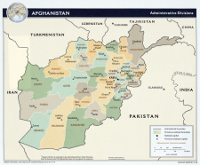Seven Afghan policemen were killed in a suicide bombing today in the northern province of Kunduz, and the Taliban have taken credit for the attack.
The policemen were killed after a Taliban suicide bomber rammed his car into a convoy in the contested district of Imam Sahib. “In this attack, seven policemen were martyred, six police and five civilians were wounded,” according to an Afghan Interior Ministry statement.
In a statement released on the Taliban propaganda website, Voice of Jihad, the group claimed it “conducted a martyr attack” and killed “more than 10 invaders and puppets.” But the International Security Assistance Force has not reported any if its soldiers killed or wounded in Kunduz.
Today’s suicide attack is the latest in the Afghan north, where the Taliban have been seeking to destabilize the region and interdict ISAF convoys moving along newly established supply lines from Tajikistan. On July 2, the Taliban sent a suicide assault team to attack the headquarters of a company working for USAID in Kunduz. Two foreign contractors, an Afghan soldier, and a policeman were killed in the attack, and the company shut down its operations.
The Taliban also carried out a brutal attack recently on Afghan police in neighboring Baghlan province. On July 24, the Taliban overran a police checkpoint in the district of Dahanah-ye Ghori and beheaded six policemen.
The US has increased its presence in Kunduz and neighboring Baghlan, and is actively hunting senior Taliban and allied terror groups’ leaders.
Background on the Taliban strongholds in the north
Over the past two years, the security situation in the northern provinces of Kunduz and Baghlan has deteriorated. The Taliban, Hezb-i-Islami Gulbuddin (HIG), the Haqqani Network, and the Islamic Movement of Uzbekistan all have a presence in the two provinces and have been attacking Coalition and Afghan forces as well as NATO supply lines from Tajikistan.
The Taliban and allied terror groups maintain safe havens in Baghlan and Kunduz, and control large portions of the provinces. Of the seven districts in Kunduz province, only two are considered under government control; the rest of the districts – Chahara Dara, Dashti Archi, Ali Abab, Khan Abad, and Iman Sahib – are considered contested or under Taliban control, according to a map produced by Afghanistan’s Interior Ministry in the spring of 2009. Two districts in neighboring Baghlan province – Baghlan-i-Jadid and Burka – are under the control of the Taliban [see LWJ report, “Afghan forces and Taliban clash in Kunduz,” and Threat Matrix report, “Afghanistan’s wild-wild North”].
Kunduz and Baghlan fall under ISAF’s Regional Command North, which is led by the Germans. The Germans have been criticized by the Afghan government and Coalition partners for failing to aid in securing the north. German troops are restricted from actively engaging in major combat operations and have largely confined their forces to base.
ISAF and Afghan security forces have been targeting the Taliban’s top leaders for the two northern provinces; several have been detained or killed this year. The Pakistanis reportedly detained the Taliban’s shadow governors for Kunduz and Baghlan in February. In April, the Afghan military claimed that the newly-named, replacement shadow governor for Kunduz was killed along with three aides.
Earlier this year, Baghlan was the scene of a local internecine battle between the Taliban and allied HIG. Seventy HIG fighters and 50 Taliban fighters were killed in fighting in the Baghlan-e-Markazi district after disagreements arose over collecting taxes. Scores of HIG fighters defected to the government after being defeated. There is no indication, however, that the taxation dispute between the two groups that spiraled into fighting has spread beyond the Baghlan-e-Markazi district.
But despite the Taliban’s losses in the north, the group remains in firm control of several districts. The Taliban have launched an assassination campaign and have also been accused of releasing poisonous gases in girls’ schools in Kunduz. Scores of Afghan schoolgirls have been hospitalized over the past several months due to the gas attacks.









2 Comments
More examples of war crimes and crimes against humanity COMMITTED BY THE TALIBAN and their AQ masters.
And please nobody give me that garbage that the taliban (which is an illegitimate and outlawed entity) didn’t sign any international treaties since that basic human rights are to be expected of all entities irregardless of treaties signed.
What group of individuals mass murder and mass execute police officers? Answer: criminals.
I predict that what could happen in Afghanistan to the good Afghans if we were to leave prematurely and leave them unprotected could rival or even exceed the tyrant Pol Pot’s Killing Fields in Cambodia.
What will it take for the world to face up to the real war criminals and those that commit crimes against humanity (meaning the Taliban, their foreign/occupier operatives and AQ masters).
SVBIED killed six police and 1 Arbaki commander, not seven police.
That tally may go up in the next couple days, however.
There was a maddrassa about 50 meters from the SVBIED and parts of the car landed in the school, hurting two of the kids. A third kid had his knee cap ripped off by ball bearing.